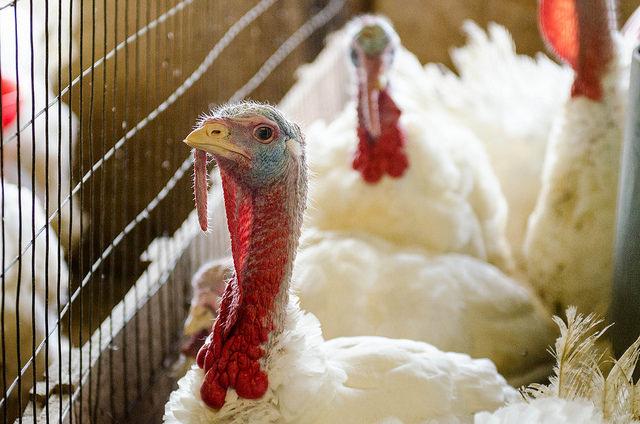Highly pathogenic H5N2 avian flu has struck turkeys on four more Minnesota farms plus one in South Dakota in an outbreak that has now affected more than 1.7 million Minnesota birds, officials said.
In an update today, the US Department of Agriculture's (USDA's) Animal and Plant Health Inspection Service (APHIS) said that Otter Tail and Roseau counties in Minnesota have been affected for the first time. The virus felled birds in a flock of 21,000 turkeys in Otter Tail County, whereas a farm housing 26,000 turkeys was affected in Roseau County.
In addition, Stearns County reported its sixth H5N2 outbreak, in a flock of 67,000 turkeys. And Kandiyohi County logged its fifth outbreak, affecting 152,000 turkeys. Kandiyohi and Stearns are the top turkey-producing counties in Minnesota, while Otter Tail is fifth, according to data from the Minnesota Turkey Growers Association. The state leads the nation in turkey production.
Roseau County is in the far northwestern part of the state, adjacent to Canada, marking by far the farthest north incursion of H5N2 in the state to date. Otter Tail, in the central western portion of the state, is also farther north than previous outbreaks.
Fourteen Minnesota counties have now been affected by 26 farm outbreaks, according to the Minnesota Board of Animal Health (MBAH). All told, 1,718,500 Minnesota turkeys have been affected since the outbreak began in the state in early March.
All the Minnesota farms reside on the Mississippi flyway for migratory birds. Experts have said wild birds may play a role in H5N2 spread.
5th South Dakota farm affected
The affected farm in South Dakota, with 66,600 turkeys, is in Roberts County in the far northeast corner of the state, adjoining both Minnesota and North Dakota, which confirmed its first H5N2 outbreak a week ago.
South Dakota has now confirmed five H5N2 outbreaks in five counties scattered throughout the eastern half of the state. All the outbreaks occurred this month, and all the affected farms lie along the Central US flyway.
Today's APHIS update also notes an outbreak among 126,700 turkeys in Wisconsin's Barron County. The Wisconsin Department of Agriculture, Trade, and Consumer Protection reported the outbreak yesterday, numbering the flock at an even 126,000.
The APHIS update noted that federal and state authorities will follow the typical outbreak response steps of quarantining affected farms, depopulating flocks, and ensuring that affected poultry do not enter the food system.
H5N2 has also surfaced in Missouri, Arkansas, Kansas, Iowa, and Montana since early March, affecting more than 2.4 million poultry in central states. Earlier in the winter it hit several poultry flocks in Washington, Oregon, and Idaho. A few detections in wild birds have been reported as well.
Minnesota enlists turkey hunters
The Minnesota Department of Natural Resources (DNR) is asking successful wild-turkey hunters in the counties at the heart of the H5N2 outbreak—Kandiyohi, Pope, Meeker, Swift, and Stearns—to present their downed birds for sample collection starting on Apr 20.
Hunters can bring their turkeys to one of four locations, where officials will take swabs and collect information at hunters' vehicles, and hunters will be able to keep their birds, the DNR said in a press release today. Officials will notify hunters if their birds test positive.
"[Highly pathogenic avian influenza] has not yet been found in wild turkeys, but it has been found in domestic turkeys in these and other Minnesota counties," said Michelle Carstensen, PhD, DNR wildlife health program supervisor. "We chose those five counties to enlist the help of hunters because they have sufficient wild turkey populations."
The DNR also recommends that turkey hunters practice good hygiene while field dressing their birds and cook the meat to a safe internal temperature to destroy any pathogens. The press release emphasized that H5N2 avian flu is considered a low risk to people and there have been no human cases to date.
Taiwan reports H5N2 outbreak
Elsewhere in outbreak news, Taiwan today reported highly pathogenic H5N2 avian flu on a farm in Pingtung County on the southern part of the island, according to a report posted by the World Organization for Animal Health (OIE).
In a flock of 2,500 geese, 590 died from the disease and the rest were culled to prevent disease spread. The farm has been quarantined, and farms within 3 kilometers of it have been placed under increased surveillance measures.
Taiwan has been grappling with many outbreaks of H5N8 and H5N2 in recent months, along with a novel H5N3 strain, but outbreaks have slowed considerably in the past several weeks.
See also:
Apr 17 USDA APHIS statement
MBAH avian flu page
Apr 17 Minnesota DNR news release
Apr 17 OIE report on Taiwan
Apr 16 CIDRAP News story "Wisconsin reports H5N2 in turkeys, backyard poultry"






















